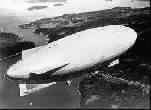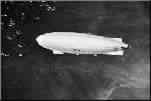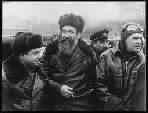|
|
|
 |
 |
 |
| 1926 Amundsen-Ellsworth-Nobile Transpolar flight in the airship Norge from Kings Bay, Spitsbergen to Teller, Alaska. |
| With Italian Umberto Nobile, the designer of the Norge, [meaning Norway] as pilot, the flight departed Kings Bay, Spitsbergen on May 11, 1926--just five days after Byrd's claimed attainment of the North Pole--and flew by way of the North Pole to Teller (near Nome), Alaska. The flight, which originated in Rome, had been touted as "Rome to Nome" but bad weather forced them to land at the small settlement of Teller just short of Nome. This flight established that there was no additional land in the Arctic Ocean on the Alaska side. Additionally, it gave Amundsen, who had previously led the first expedition to reach the South Pole, the distinction of being the first person to travel to both poles of the earth. |
| Polar First: First undisputed attainment of the North Pole by air and first crossing of the polar sea. |
| First-hand account: Amundsen, et al.: First Crossing of the Polar Sea, 1926, is what an account of a real flight should be. In addition to Amundsen's and Ellsworth`s accounts, the book contains sections by Hjalmar Riiser-Larsen, second-in-command and navigator, and Prof. Finn Malmgren, meteorologist. |
| Photos: For a contemporary photo of the Norge mooring mast at Kings Bay, (click here). |
| For 1939 photos of Kings Bay and the tiny settlement of Ny Ålesund and of the airship hangar, (click here). |
| |
| |
| 1928 Wilkins-Eielson airplane flight from Pt. Barrow, Alaska to Green Harbor (Gronfjorden), Spitsbergen. |
| Australian pilot George (later Sir Hubert) Wilkins and Alaskan pilot Ben Eielson made a daring flight from Pt. Barrow, Alaska to Green Harbor, Spitsbergen in a single-engine Lockheed Vega on April 15-21, 1928. Their route of flight took them close to the northern coast of Greenland and they determined there was no additional land between Greenland and the North Pole. A snowstorm while enroute forced them to land on a remote island they later learned was named Dead Man's Island and the flight included a harrowing take off from this spot. Wilkins, a British subject, was later knighted for his part in this historic flight. |
| Polar First: First crossing of the polar rim, Alaska to Spitsbergen, by airplane. |
| First-hand account: Wilkins, G. H., Flying the Arctic, contains a description of this flight as well as other flights he and Eielson made from the northern coast of Alaska. |
| Photo: from the book, Flying the Arctic. |
| |
| 1928 Nobile north pole flight in airship Italia from Kings Bay. |
| Italian Umberto Nobile, who designed and piloted the Norge on its 1926 transpolar flight, returned to Spitsbergen in 1928 for another north polar flight. However, his redesigned airship the Italia crashed on the ice some 60 miles north of Spitsbergen on the return from a claimed attainment of the North Pole. Nobile and several others were in the gondola when it hit the ice pack and were thrown out onto the ice. A Swedish pilot, Lundborg, eventually reached the crash site by air and removed Nobile to Kings Bay. However, Lundborg damaged his plane on the return trip to remove more survivors and had to be rescued himself. Eventually a Russian icebreaker reached the crash site and rescued the remaining survivors. As a further tragedy, the great Roald Amundsen lost his life in a plane crash searching for Italia survivors. |
| Polar First: the Italia crash sparked the first massive, international air-sea rescue in the far north. |
| First-hand account: Nobile, U., My Polar Flights, written in 1961. contains Nobile's version of the Italia disaster. A number of people who were involved in the rescue operations also wrote books (see bibliography). |
| |
| |
| 1931 Polar flight of the airship Graf Zeppelin. |
| The Graf Zeppelin flew under the command of airship captain Dr. Hugo Eckner who had gained world renown by commanding the 1929 around the world flight of the Graf Zeppelin. The passenger list for the 1931 polar flight was an international who`s who of polar and aerial exploration, including Lincoln Ellsworth who had flown with Amundsen to 88ºN in 1925 and on the 1926 Norge transpolar flight. The flight departed from the Zeppelin base at Friedrichshafen, Germany and returned to Friedrichshafen 8 days later after surveying the Russian polar island groups in the Arctic Ocean. One spectacular aspect of the flight was a brief water landing at Hooker Island in the Russian Arctic and an exchange of mail with a Russian icebreaker. |
| Polar First: First aerial survey and mapping of Russian island groups in the Arctic Ocean: first air-sea exchange of mail in the far north. |
| First-hand accounts: Eckner, H., My Zeppelins, written in 1958 contains Eckner's reminiscences of Graf Zeppelin flights including the 1931 polar flight. Ellsworth, L., Beyond Horizons, written in 1938, contains Ellsworth's first-hand account of the flight. |
| Photo: from Eckner's book, My Zeppelins. |
| For more information on this flight as well as an overview of early polar aviation history, see "The 1931 Polar Flight of the Airship Graf Zeppelin." |
| |
| |
| 1937 Russian scientist Otto Schmidt and pilot Vodopyanov, airplane landing on ice near North Pole. |
| In the 1930s, the Russians dominated polar aviation and set numerous world records, including the first transpolar airplane flight from Russia to the U.S. Another spectacular feat was the establishment of the first polar ice station, SP-1, the first of many floating ice staions that now dot the Arctic Ocean. On May 21, 1937, Russian polar scientist, Otto Schmidt, pilot Georgi Vodopyanov, and several crewmenbers landed on the ice near the North Pole preparatory to establishing SP-1. |
| Polar First: First airplane landing on the ice in the near vicinity of the North Pole; first polar ice-station. |
| First-hand account: Brontman, L., On Top of the World. contains Brontman's account of the SP-1 expedition. Lazar Brontman was a Soviet journalist for Pravda who accompanied the Soviet expedition to establish SP-1 and remained with them for three months. |
 |









